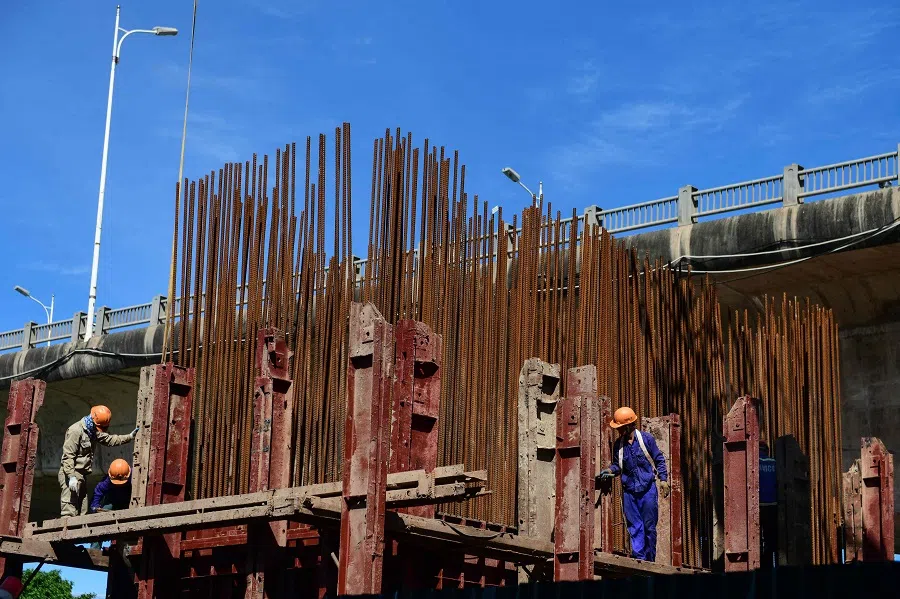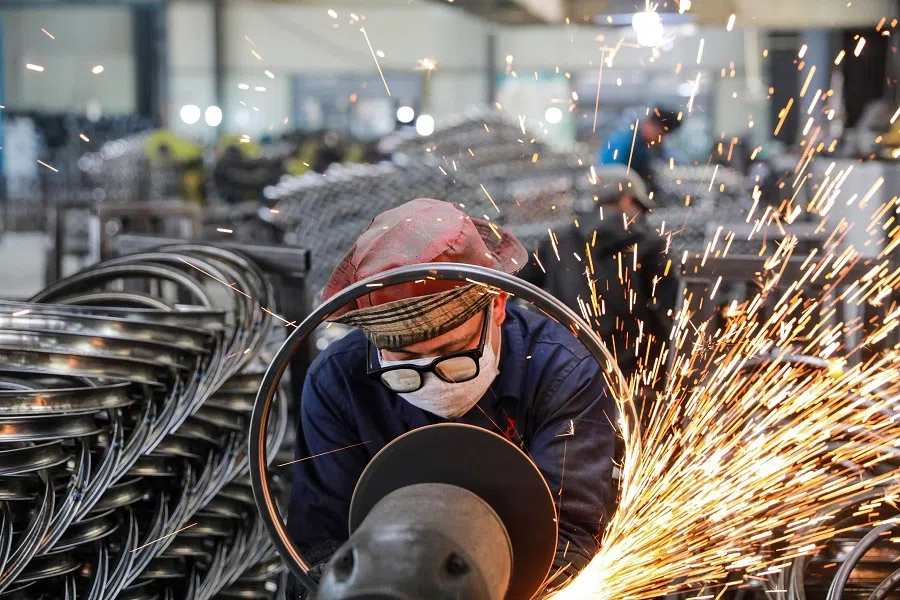Shifting supply chains from China to Southeast Asia is hard but necessary
Amid the effects of the China-US trade war and the Covid-19 pandemic, global manufacturers are seeing the need to adopt a "China+1" strategy by diversifying their supply chains or business operations beyond China. However, moving parts of the supply chain to the Southeast Asian region is not so straightforward. What challenges do they face and how are they overcoming them? Will China's position as the "world's factory" be shaken and how will its economic model be changed?

When the latest Apple headphones are no longer marked "Assembled in China", and are instead "Assembled in Vietnam", is it a sign that the hub for global manufacturing has shifted from China to Southeast Asia?
The effects of the China-US trade war and the Covid-19 pandemic have been profoundly felt by manufacturers globally, pushing businesses to roll out their "China + 1" strategy, which involves diversifying their supply chain or business operations beyond China to mitigate risks.
Yet while the "+1" strategy may seem sound, supply chain planning is not a simple arithmetic equation but a complex issue fraught with challenges.
Executing the '+1' strategy
According to an industry insider employed in the supply chain management unit of a well-known European toy firm, his employer - like many other multinationals - had been shifting segments of its supply chain out of China for some time because of cost considerations. The US-China trade war that broke out three years ago, and the ensuing tension between the two biggest economies in the world, hastened the execution of this strategy.
Speaking on condition of anonymity as company staff were not authorised to speak to the media, the industry insider revealed that the scale and complexity of the shift meant that all the different departments within the enterprise were affected. But despite having spent four years on the plan, it has yet to be fully implemented due to the massive coordination required in adjusting the allocation of capacity and resources across its global operations.
While many businesses have been moving some of their manufacturing capacity to a Southeast Asian nation as a way of circumventing the tariffs resulting from the US-China conflict, parts of their supply chains serving the domestic Chinese market were still kept within China. - Li Mingjiang, Associate Professor, S Rajaratnam School of International Studies (RSIS), Nanyang Technological University

Gerry Ong, managing director of SMT Technology which has regular dealings with MNCs in China, said "+1" strategies were formulated by many enterprises, but the breadth, scale and complexity of the plan made rollout a challenge.
While many businesses have been moving some of their manufacturing capacity to a Southeast Asian nation as a way of circumventing the tariffs resulting from the US-China conflict, parts of their supply chains serving the domestic Chinese market were still kept within China, said Li Mingjiang, associate professor at the S Rajaratnam School of International Studies (RSIS), Nanyang Technological University.
The observation is similarly shared by Mr Ong who said the shift is actually a separation of operations serving China's domestic market from operations serving markets outside of China. The division rendered the two parts independent of each other in terms of accounting and operations.
Preferred '+1' destination
As for the choice of country or region to move to, the factors under consideration appear to be similar for many companies, with Vietnam emerging as the top choice based on overall labour costs, political stability and social and cultural factors. This has contributed significantly to Vietnam's average annual economic growth of 6-7% over the past decade.
When US tech giant Apple relocated some of its AirPods production lines from China to Vietnam last year, it marked a significant development for Vietnam, making it one of the biggest beneficiaries of the "+1" strategy. The move, in the second quarter of last year, involved a total capacity of three to four million sets of headphones (about 30% of its total production).
Vietnam's win, however, can also be attributed to the glaring disadvantages of other destinations.

In late 2020, a number of Apple suppliers, including Foxconn and Pegatron Corp, as well as iPad tablet manufacturer Compal Electronics, also expanded in Vietnam.
Vietnam's win, however, can also be attributed to the glaring disadvantages of other destinations.
Wu Wei, an executive at a multinational Internet company who had relocated from China to Vietnam, said that his employer had been making plans for the move since 2014 and they had looked at a number of options, including Malaysia and India.
Mr Wu said India had appeared to be a better choice because of size and scale, but the country's culture and regulatory framework were not a good fit for the company. Public institutions and systems were also weak - as can be seen by the nation's pandemic response.
In comparison, Vietnam offered not only low labour costs, but also a similar cultural outlook, Mr Wu added. "Vietnamese were more reserved and favoured stability, qualities that were considered important for the nature of manufacturing, which required putting systems over individuals, and processes over personalities."
Still, relocating to Vietnam was no mean feat. As Mr Wu recalled, the biggest challenge was the integration of local management teams. Even though everyone could communicate in English, the local mindset was still different, as were the working habits, and a lot of time had to be spent on training. Based on his experience in helping companies with their move, SMT Technology's Mr Ong said one of the biggest issues was the lack of knowledge and understanding of the target destinations. Sticking with the same mentality and ways of working in China can put companies at odds with local customs or even be in breach of local laws.

Vietnam's relatively small size and the congregation of global clients meant that competition for local resources has intensified considerably.
Mr Wu said the high turnover of staff was another issue facing many foreign enterprises; experienced workers can often find new employment in a matter of days. "If they are unhappy at work, they just leave immediately."
There were also constraints arising from Vietnam's development. The Financial Times ran a report in December last year pointing out the lack of depth in Vietnam's labour force in comparison to China's. Although demand in industrial parks remains high, there was a lack of supporting infrastructure.
Yu Hong, senior research fellow at the East Asian Institute, National University of Singapore said: "A mature 'world's factory' requires skilled labour, a stable political environment, upstream and downstream parts supply, and comprehensive infrastructure and supporting services, including logistics and ports management. On this set of criteria, Vietnam still falls short."
"The China supply chain remains the biggest and sturdiest to date." - Gerry Ong, Managing Director, SMT Technology
Damaging but not lethal
A mature manufacturing supply chain cannot be easily replicated - this was a point collectively cited by observers to explain why the "+1" strategy may have an impact but does not completely undermine China's standing as the factory of the world.
Mr Ong said a manufacturing supply chain is in fact an ecosystem. Businesses operating in China deploy models that meet their needs, but there exists synergies between the different operators that enable them to work together smoothly - something that another country cannot offer as yet. He added: "The China supply chain remains the biggest and sturdiest to date."

Broadly agreeing, Dr Li said: "China's greatest advantage comes from the clustering of industries, and each of these clusters have their local characteristics." One example he raised was the Jiangsu, Zhejiang and Shanghai region, or the Dongguan area. All the supplementary services required by the manufacturers in the clusters can be found within a radius of tens of kilometres - including packaging design, innovation, consulting, and others. Such proximity and access cannot be replicated easily in another country.
According to Dr Yu, China's exports grew 1.9% last year despite the Covid pandemic. Last year's extraordinary conditions gave China the opportunity to reinforce its leading position in international trade.
But the country's many strengths cannot hide the damage inflicted by the "+1" strategy, the most severe of which is the worsening inequality in economic development between different regions in China.
Dr Li said the adoption of the "+1" strategy caused many low-end manufacturing activities to move out of China, which in turn damaged the economic and tech development of its less-developed central-western regions. According to his analysis, industrialisation in some of these less-developed areas had brought about better developmental prospects that were now curtailed with the implementation of "+1" strategies.
"Many industrial parks, economic development zones and their ilk had been constructed in the central western region of China, but there were actually very few pull factors that would attract businesses to move in," he said. "The problem is now being exacerbated as parts of supply chains are relocated, and industrial development slows down or stops, hitting these areas hard. This will worsen the inequality in economic development between the central-western region and other regions in China."

However, as Dr Yu sees it, the "+1" strategy may have a positive impact, as China may be forced to change its economic model from being export-driven to being driven by domestic demand.
Dr Yu believes that China also has the opportunity to reinforce its position as a manufacturing hub as it enters into more free trade agreements, such as the Regional Comprehensive Economic Partnership. These trade deals could deepen China's role as the core of regional supply chains, which would lift the country from the lower end to the higher end of manufacturing, encompassing research and development, and design.
Legal constraints in navigating US-China tussle
Rising costs of labour, raw materials, land and other factors of production may be the primary considerations for multinationals moving out of China, but the US-China tensions have also had a significant effect. Businesses caught in the the tussle between these two economic giants need to do all they can to mitigate risks as they seek survival.
Lim Tai Wei, adjunct senior research fellow at the NUS East Asian Institute, pointed out that the impact of the US-China conflict comes not only in the form of tariffs, but also in other less obvious forms such as legal constraints.
He said that the "China + 1" strategy adopted by many multinational companies resulted from the Trump-era trade war and the desire to decouple the US economy from that of China's. This is fundamentally different from the original "China + 1" strategy proposed by Japan against the backdrop of anti-Japan sentiments in China.

Under the concept of decoupling, China and the US are rivals in geopolitics, technology, and many other areas, and multinational enterprises need to proceed with caution when it comes to their operations in China, Dr Lim added.
"For manufacturers of sensitive components, such as chip makers from Taiwan, there might also be legal conflicts involved," he said. Much of the technology applied had come from the US, so when the US shared this knowhow with its ally, it came with a number of conditions. Naturally, the manufacturers employing this technology would also have to abide by the legal requirements.
Geopolitics should also be a key consideration for companies, especially those in the semiconductors, artificial intelligence, electric vehicles, and other core industries, said Yu Hong, senior research fellow at the East Asian Institute, National University of Singapore. Many Western countries, including the US, believe they should not stake their supply chains entirely on China, which they perceive as being at odds with them in values.
Citing the example of US President Joe Biden's statement that he will not let China win the electric vehicle race (made during a visit to the automaker Ford's plant last month), Dr Yu said it showed the West's intent to cut its dependence on China.
Related: Chinese financial institutions drawn to Singapore and Southeast Asian markets | Rich China tycoons park family offices in Singapore | Singapore a popular base for China tech firms | China e-commerce players tap ASEAN market for growth | Southeast Asia: A hotspot for Chinese enterprises in the post-pandemic era?





